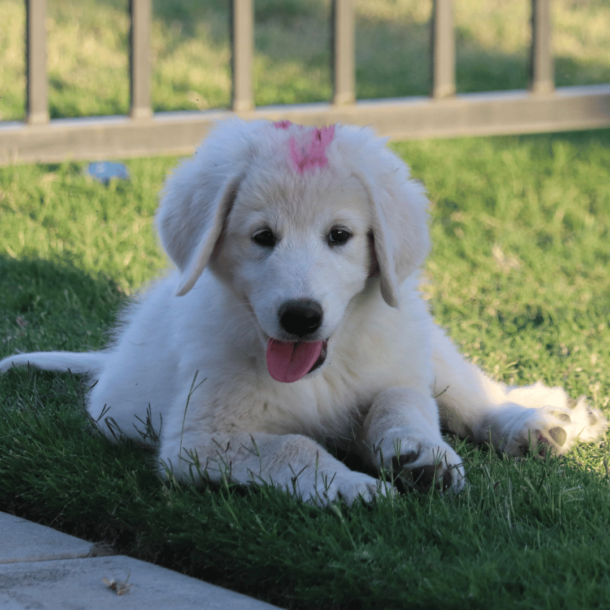The critical weeks when puppies learn the “language” of livestock – and why choosing the right teachers matters more than you think.
At 5 weeks old, our current litter has reached one of the most exciting milestones in livestock guardian development: full-time integration with their “trainer” goats.
No more supervised visits or controlled introductions. These confident young Maremma LGD puppies now live, eat, and explore alongside a carefully selected group of goats who will teach them everything about being part of a multi-species family.
But here’s what most people don’t understand about livestock integration: You can’t just turn puppies loose with random livestock and hope for the best. The animals you choose as “teachers” during these critical weeks will shape your livestock guardian dog’s relationship with livestock for life.
Get it right, and you create dogs that naturally protect what they bond with. Get it wrong, and you might create the next Sarah—dealing with dogs that harm instead of protect.

Trainer Livestock Selection for LGD Puppies
After years of raising livestock guardian dogs, I’ve learned that not all livestock make good puppy teachers. The animals I choose for this crucial role must meet very specific criteria:
The Ideal Trainer Goat:
- Experienced with puppies and comfortable around young dogs
- Patient but not passive – will set gentle boundaries when needed
- Stable temperament – neither aggressive nor overly flighty
- Appropriate size for the age of puppies (younger puppies vs. massive teenage dogs)
- Well-integrated with adult livestock guardian dogs already
This year, I’m experimenting with adding Rain, a Nigerian Dwarf who’s new to the puppy trainer role. She’s teaching me—and the puppies—valuable lessons about appropriate boundary setting.

How Trainer Livestock Teach LGD Puppies Respect
Yesterday, I watched Rain demonstrate exactly what good livestock “correction” (a term I strongly dislike but one a lot of people use so I’ll use it here) should look like. When a curious puppy approached to sniff her, she lowered her head in warning. The puppy persisted, so Rain gave a gentle but firm head butt that sent the little one rolling—not hurt, just surprised.
The puppy’s response told me everything I needed to know: No fear, no defensive reaction, just a thoughtful pause before choosing to interact with more welcoming goats nearby.
Within minutes, I saw the same puppy standing comfortably near Rain at a respectful distance, with Rain relaxed and accepting.
This is exactly how livestock should teach puppies: Clear communication, appropriate consequences, and mutual respect.

What Good Training Looks Like vs. What to Avoid in Livestock Integration
Appropriate Livestock Behavior:
- Gentle warnings before escalating to correction
- Proportional responses to puppy behavior
- Quick return to normal after boundary setting
- Tolerance of respectful proximity
- Calm, predictable temperament
Red Flag Behaviors I Remove Immediately:
- Constant aggression toward puppies minding their own business
- Unprovoked attacks on puppies simply walking past
- Overly flighty behavior that triggers puppy chase instincts
- Bullying or persistent harassment
- Fearful reactions that create anxiety in the environment

Why these distinctions matter: Puppies who experience constant bullying become either fearful of livestock or aggressive toward them. Dogs who learn that livestock are “fun to chase” because of flighty animals develop prey drive issues that may never resolve.
The wrong puppy trainer animals don’t just fail to teach—they actively create problems that may last a lifetime.
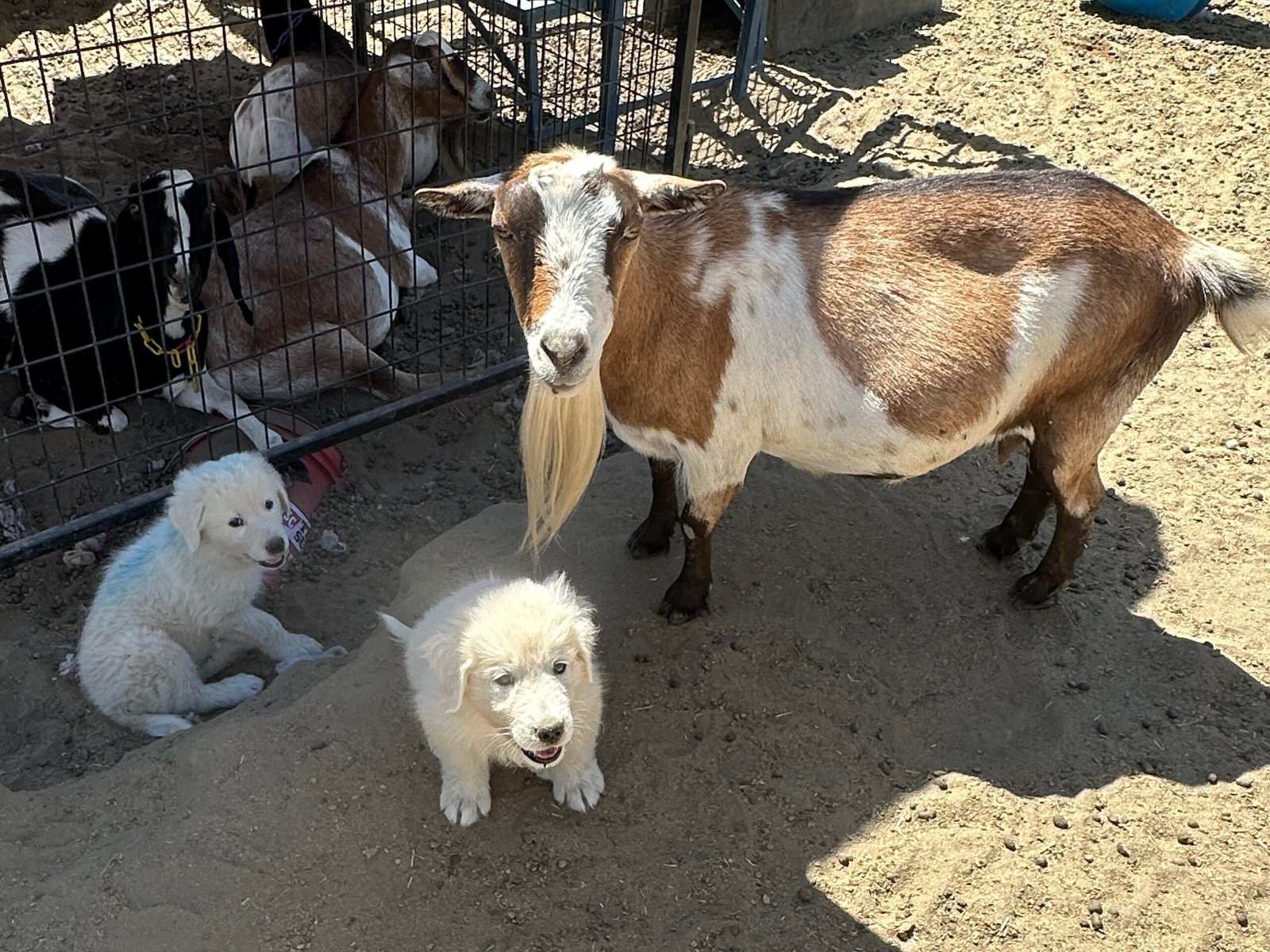
The “Foreign Language” Principle
I often tell families that puppy livestock integration is like language acquisition. Children who learn multiple languages while young speak each fluently with perfect accents. Adults learning a second language struggle with pronunciation and grammar for years.
Puppies living intensively with livestock during weeks 5-12 are learning the “language” and “culture” of their stock. They’re absorbing:
- Communication signals (body language, vocalizations, movement patterns)
- Social hierarchy and respect protocols
- Daily rhythms and behavioral expectations
- Appropriate interaction styles for different situations
- Protective instincts based on genuine relationships
Miss this window, and you’ll spend years trying to teach what should have been effortless.
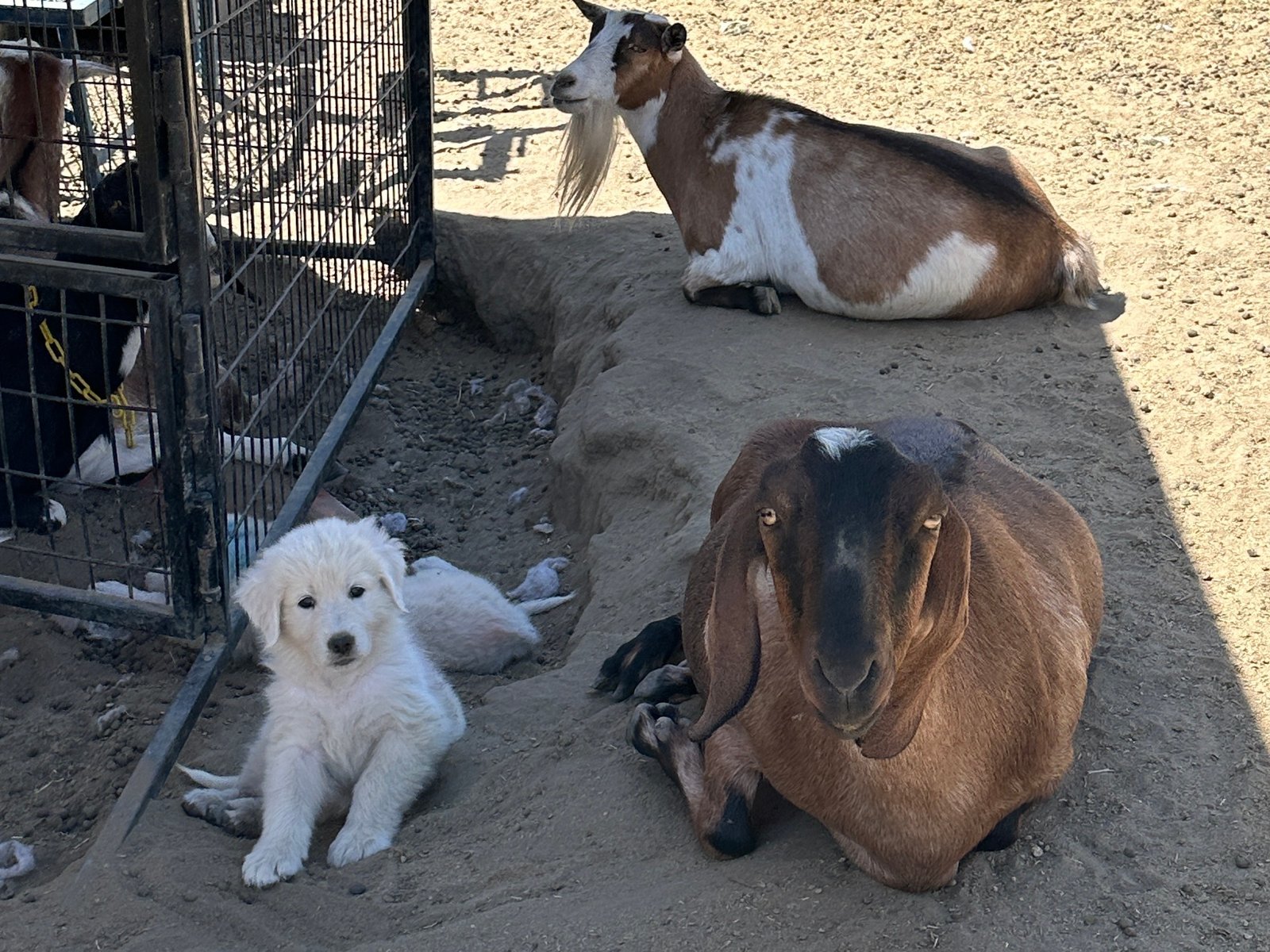
The Role of Adult Livestock Guardian Dogs in Puppy Livestock Training
Many people assume adult dogs “train” puppies through corrections and dominance. In my experience, this approach creates fearful or aggressive dogs—I’ve purchased such dogs from other breeders, and they were always problematic.
My adult Maremmas teach through modeling, not bullying. Puppies watch how experienced dogs interact with livestock and naturally copy appropriate behaviors:
- Calm, confident presence around stock
- Protective positioning without harassment
- Appropriate play boundaries with livestock
- Response protocols to different situations
The mother dog’s role is particularly crucial. She demonstrates patience, gentleness, and appropriate livestock relationships. Mothers who become aggressive with puppies early often produce defensive, reactive offspring.
I select specific adult dogs who excel at puppy mentoring and introduce them around 5 weeks. These dogs naturally guide puppy development without force or intimidation.
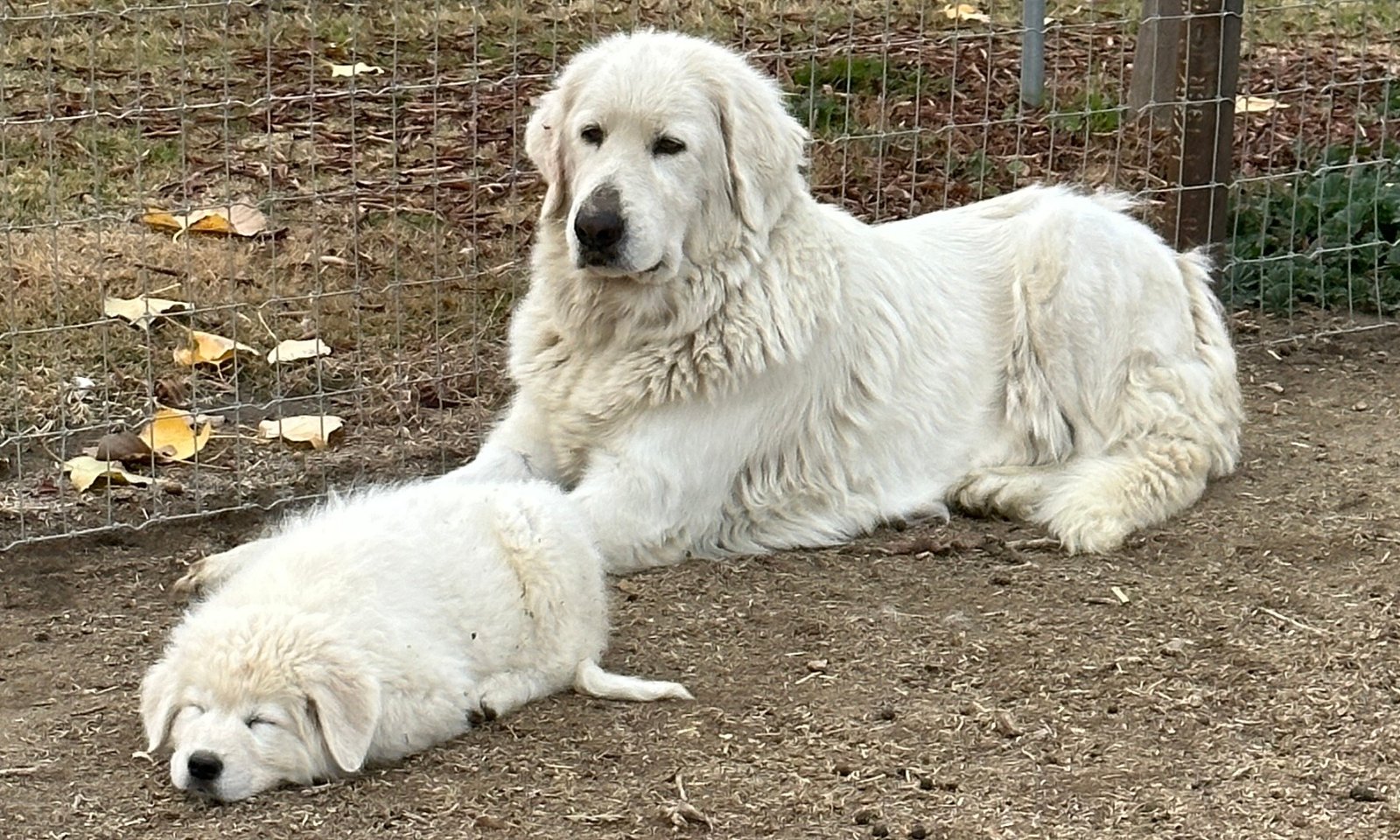
What You Won’t See Me Doing in my LGD puppy program
Unlike some breeding approaches, I don’t allow:
- Adult dogs to “correct” puppies aggressively
- Livestock to constantly harass or bully young dogs
- Unsupervised integration without careful animal selection
- Random stock mixing without temperament evaluation
- Puppies to “figure it out” through negative experiences
This isn’t permissive—it’s strategic. Positive early experiences create confident livestock guardian dogs who protect from love, not fear.
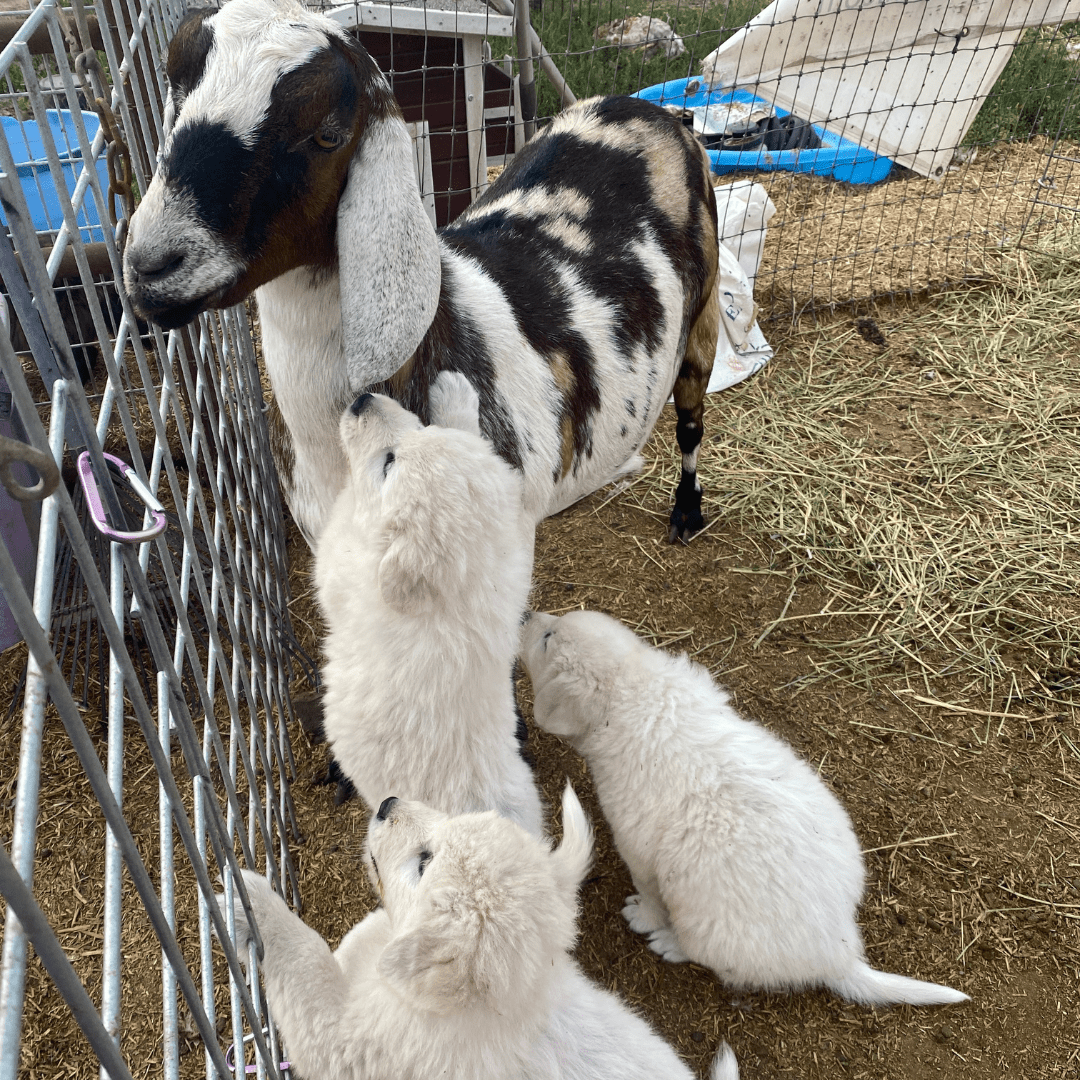
Monitoring LGD Puppy-Livestock Interactions
During these crucial weeks, my job isn’t to train—it’s to observe and adjust. I watch for:
Positive Indicators:
- Calm curiosity about livestock
- Respectful approach to different animals
- Quick learning from gentle corrections
- Relaxed body language in mixed groups
- Natural protective positioning as they mature
Warning Signs from puppies:
- Excessive fear or avoidance of stock
- Persistent rough play that escalates
- Predatory interest (stalking, intense focus)
- Defensive reactions to normal livestock behavior
- Inability to read livestock signals
Warning Signs from the livestock:
- Bullying of puppies: chasing, head butting, or “correcting ” them for no reason
- Flighty behavior: This may trigger the puppies to chase
- Goats that appear nervous around the puppies, which can indicate the pups are behaving inappropriately in my absence
Early intervention prevents permanent problems. A quick adjustment to the trainer animal group or environmental management can redirect concerning behaviors before they become established patterns.
If a particular goat is causing problems, I remove it from the puppy pasture. Not all goats make good puppy trainers and some may simply not be a good candidate for these particular puppies.

Why This Matters for Your Investment
When evaluating LGD breeders, ask specific questions about their livestock integration program:
- What specific animals do you use as puppy trainers?
- How do you select trainer livestock vs. your general herd?
- What behaviors do you allow vs. prevent during integration?
- How do you monitor puppy-livestock interactions?
- Can you show me videos of your integration process?
- What’s your protocol when problems arise?
Red flags:
- “They just live with the herd” (no selection process)
- “The livestock teach them respect” (allowing bullying)
- “It’s all instinct” (no active management)
- “Some puppies just aren’t suited for working LGD roles” (blame rather than technique)
- Inability to show or explain their process

The Investment in Proper Livestock Selection
Creating a group of proven puppy trainer animals takes years and careful observation. Each goat in my current group has demonstrated the right temperament, experience, and teaching ability over multiple litters. My best puppy trainers have a permanent position in this role. They are worth their weight in gold and live permanently in the puppy pasture. I won’t sell them as long as I am breeding and training Maremmas. I don’t even breed most of them because they are more valuable to me as puppy trainers than breeding animals.
I do try new goats with the puppies from time to time. Rain is an experiment—and that’s exactly how it should be done. Careful introduction, constant monitoring, and willingness to adjust based on results.
This level of intentionality in livestock selection is one more way we ensure every puppy gets the optimal foundation for livestock guardian dog success.

What’s Next In Our Maremma LGD Socialization Program?
As these puppies continue maturing with their trainer goats, you’ll see the natural protective relationships develop that make exceptional livestock guardians. Next week, I’ll introduce you to my star puppy trainer dog—an adult female who has mentored dozens of young Maremmas and demonstrates exactly what positive canine guidance looks like.
Because creating exceptional livestock guardian dogs isn’t just about genetics or basic socialization—it’s about understanding every element that shapes a young LGD’s relationship with the animals they’ll one day protect.
This step-by-step approach to LGD puppy socialization and livestock integration ensures each pup develops into a calm, trustworthy livestock guardian dog.
Want to learn more about our livestock integration process? Schedule a free Maremma discovery call
Ready to reserve your properly integrated guardian? Apply for our waiting list – advanced socialization producing remarkable results
Questions about livestock selection or integration techniques? Download our “Evaluating LGD Breeders” guide

Next week: Discover how we keep our puppies healthy through our vaccination and parasite control program, combined with our Puppy Parlor rearing system.

